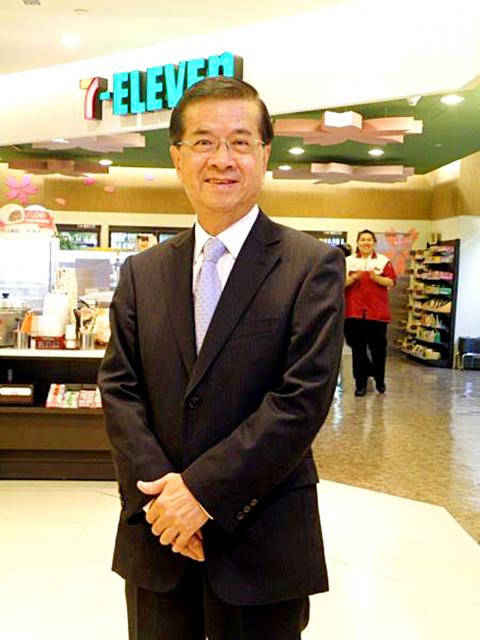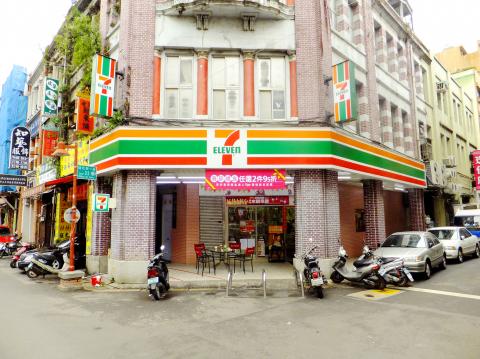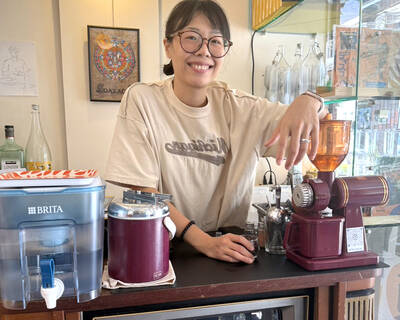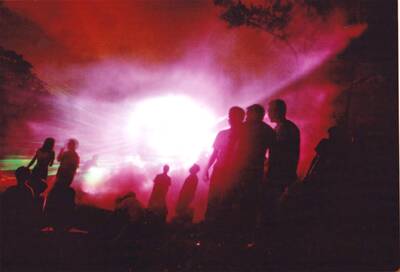Feb. 5 to Feb. 11
It’s hard to believe that today’s ubiquitous 7-Eleven was once labeled as the “prodigal son of Uni-President Enterprises Corp.” But during its early days, the convenience store cost the corporation more than NT$2 billion in total losses.
Launching its first store in February 1980 on Taipei’s Changan E Road, the venture had already eaten into about half the original capital of NT$1.9 billion by September 1982.

Photo: Yang Ya-min, Taipei Times
“Besides Uni-President, other shareholders had little desire to keep the stores running,” Lee Jen-fang (李仁芳) writes in the book, 7-Eleven Takes Over Taiwan (7-Eleven 統一超商縱橫台灣).
At the same time, foreign and local investors bombarded Uni-President with calls about acquiring the stores. But the corporation refused all offers, instead buying out the other shareholders and taking full control over the venture by incorporating it into the company as its “supermarket department.”
It would take several more years for the company to finally turn a profit, but this was the beginning of its 7-Eleven empire in Taiwan.

Photo courtesy of Wikimedia Commons
RISE OF THE MINIMART
The late 1970s saw the rise of the two food giants of Uni-President Enterprises Corp (UPE, 統一企業) and Wei Chuan Foods Corp (味全食品) in response to increased competition in the consumer market.and need for more streamlined and efficient operations.
However, the first mini-market chain was launched by the Council of Agriculture, Taipei City Government and Youth Development Administration in 1977. According to the a 60th Anniversary publication by Wei Chuan (who later purchased the chain), government officials launched this venture after visiting the US and noticing how clean their supermarkets were compared to the traditional markets of Taiwan.
In 1979, UPE simultaneously opened 14 “modern convenience stores” across the country. Run as a subsidiary, the company held half the shares and gave the rest to dealers, family and friends. The corporation not only wanted to create a clean and bright shopping experience, but also hoped to have complete control over the channels of distribution for its products by running its own stores.
It was a daring venture as the average annual income was less than US$2,500 back then, says Hsu Chung-jen (徐重仁), who played a key role in the rise of 7-Eleven.
“As a food producer, Uni-President jumped straight into the unfamiliar world of retail and chain stores, and opened 14 stores at once with the intent of opening more. They did not even understand the basic differences between an independent store and a retail chain,” he says.
Hsu says they started out working almost 20 hours a day. He and two colleagues borrowed two desks at the parent company to conduct business, but when the company needed the desks they were relegated to a couch by the receptionist.
Hsu adds that the stores struggled because they were not able to fully identify customer needs.
“To fulfill the one-stop-shop needs of our customers, if someone wanted a broom we would start selling brooms. By the end, we had seven or eight types of detergent and milk formula and even sold vegetables, fresh meat and fish,” Hsu says.
GROWING PAINS
Hsu tried to collaborate with US corporations, but talks were stalled due to the US cutting diplomatic ties in 1979. Finally, Southland Corporation, which ran 7-Eleven in the US, reached out and the two companies signed a deal to run the stores under the 7-Eleven module and moniker.
Southland’s directive was to establish uniform, modern stores that would eventually replace traditional “mom-and-pop” businesses. They targeted housewives primarily and the initial stores were all located in residential areas. As its name suggests, the initial stores opened at 7am and closed at 11pm. And like its US counterparts, it sold Slurpees and other signature items.
However, Hsu noticed that due to the different nature of residential areas in the US and Taiwan, the US-mandated module was not attracting as many customers as they expected. Their prices were also higher — and Taiwanese housewives then were much more sensitive to prices than their US counterparts.
In 1981, the stores experimented with 24-hour service, but its products did not attract late night shoppers and soon reverted to its original hours. The franchising module did not work either as it was uncommon in Taiwan at that time.
Hsu wanted to localize the stores by eschewing the Western fast food for tea eggs and meat buns, but Southland objected on the grounds that it would ruin the image of the store. Hsu insisted, and tea eggs are a staple of all convenience stores today.
The store experienced massive losses, but still had the full support of management. Hsu returned to the fold after a short departure and got rid of 35 underperforming locations, mostly in residential communities. They analyzed the sales revenue from each store and were confident enough in 1983 to make one of the stores permanently 24-hours.
The evolution continued from there. As more women went to work, 7-Eleven in 1985 launched its signature series of microwavable meals. It opened stores in more visible areas and poured money into advertising, also adjusting its target market to the 18 to 35 crowd who were less sensitive to higher prices.
In 1986, six years after the initial venture, the chain made a profit for the first time. There was still a long road to climb, but 7-Eleven was the prodigal son no more.
“We can make up what we lost during those six years in a month or two now,” the late Uni-President founder Kao Ching-yuan (高清愿) said in 1995.
Today, there are 5,235 7-Elevens across the nation, and UPE just opened its first staffless store at their headquarters in Taipei on Monday.
Taiwan in Time, a column about Taiwan’s history that is published every Sunday, spotlights important or interesting events around the nation that have anniversaries this week.

Cheng Ching-hsiang (鄭青祥) turned a small triangle of concrete jammed between two old shops into a cool little bar called 9dimension. In front of the shop, a steampunk-like structure was welded by himself to serve as a booth where he prepares cocktails. “Yancheng used to be just old people,” he says, “but now young people are coming and creating the New Yancheng.” Around the corner, Yu Hsiu-jao (饒毓琇), opened Tiny Cafe. True to its name, it is the size of a cupboard and serves cold-brewed coffee. “Small shops are so special and have personality,” she says, “people come to Yancheng to find such treasures.” She

The low voter turnout for the referendum on Aug. 23 shows that many Taiwanese are apathetic about nuclear energy, but there are long-term energy stakes involved that the public needs to grasp Taiwan faces an energy trilemma: soaring AI-driven demand, pressure to cut carbon and reliance on fragile fuel imports. But the nuclear referendum on Aug. 23 showed how little this registered with voters, many of whom neither see the long game nor grasp the stakes. Volunteer referendum worker Vivian Chen (陳薇安) put it bluntly: “I’ve seen many people asking what they’re voting for when they arrive to vote. They cast their vote without even doing any research.” Imagine Taiwanese voters invited to a poker table. The bet looked simple — yes or no — yet most never showed. More than two-thirds of those

In July of 1995, a group of local DJs began posting an event flyer around Taipei. It was cheaply photocopied and nearly all in English, with a hand-drawn map on the back and, on the front, a big red hand print alongside one prominent line of text, “Finally… THE PARTY.” The map led to a remote floodplain in Taipei County (now New Taipei City) just across the Tamsui River from Taipei. The organizers got permission from no one. They just drove up in a blue Taiwanese pickup truck, set up a generator, two speakers, two turntables and a mixer. They

Former Chinese Nationalist Party (KMT) chairwoman Hung Hsiu-chu’s (洪秀柱) attendance at the Chinese Communist Party’s (CPP) “Chinese People’s War of Resistance Against Japanese Aggression and the World Anti-Fascist War” parade in Beijing is infuriating, embarrassing and insulting to nearly everyone in Taiwan, and Taiwan’s friends and allies. She is also ripping off bandages and pouring salt into old wounds. In the process she managed to tie both the KMT and the Democratic Progressive Party (DPP) into uncomfortable knots. The KMT continues to honor their heroic fighters, who defended China against the invading Japanese Empire, which inflicted unimaginable horrors on the